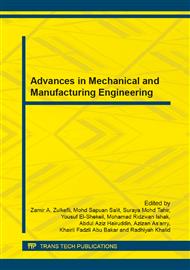[1]
J. Kempton: J. Sound Vib. Vol. 48 (1976) pp.475-483.
Google Scholar
[2]
Pierre Germain, Active Control of Run-up Noise from Propeller Aircraft, M. App. Sc. Thesis, Uni. British Columbia, May (2000).
Google Scholar
[3]
Sven Johansson, Active Control of Propeller Induced Noise in Aircraft - Algorithms & Methods, PhD Thesis, Department of Telecommunications and Signal Processing, Blekinge Institute of Technology, Sweden, December 2000-sjo.
Google Scholar
[4]
Oliver Pabst, Thomas Kletschkowski and Delf Sachau, Combined Active Noise Control and Audio In A Light Jet, The 16th Int. Congress on Sound and Vibration, Krakow, 5-9 July (2009).
Google Scholar
[5]
Griffin, The Control Of Interior Cabin Noise Due To A Turbulent, MSc Thesis, VPISU, (2009).
Google Scholar
[6]
Kusni, M, Soenarko, B., J. Science and Math, Vol 2 No. 2, (2001).
Google Scholar
[7]
Kusni, M, Soenarko, B., Dipole Wave Cancellation Using a Multipole Secondary Source, Symposium on Wave Propagation, Sep (2001).
Google Scholar
[8]
Kusni, M., The Active Noise Control Of Propeller Noise Using a Multipole Secondary Source, paper ICAS 2002-852.
Google Scholar
[9]
A. F. Seybert, B. Soenarko, F. J. Rizzo and D. J. Shippy, J. of Vib., Acoust., Stress and Reliab. 106(3), 414-420, (1984).
Google Scholar
[10]
J.L. Hess and A.M.O. Smith, Calculation of Potential Flow about Arbitrary Bodies, Progress in Aeronautical Sciences, Vol. 8, pp.1-138, (1967).
DOI: 10.1016/0376-0421(67)90003-6
Google Scholar
[11]
R. Harijono Djojodihardjo and Sheila E. Widnall, AIAA JOURNAL, Vol. 7, No. 10, October (1969).
Google Scholar
[12]
H Ashley, and W P Rodden, Annual Review of Fluid Mechanics, Vol. 4: 431-472 , January (1972).
Google Scholar
[13]
Harijono Djojodihardjo, Application of Fast Multipole Boundary Element Method for Unified FMBEM-FEM Acoustic-Structural Coupling, Proceedings, International Astronautical Congress 2009, Paper number IAC-09. C2. 3. 5.
Google Scholar
[14]
Kok Hwa Yu, A. Halim Kadarman, Harijono Djojodihardjo, Development and implementation of some BEM variants - A critical review, Engineering Analysis with Boundary Elements, (2010).
DOI: 10.1016/j.enganabound.2010.05.001
Google Scholar
[15]
Harijono Djojodihardjo, Journal of Mechanics Engineering and Automation 3 (2013) 209-220.
Google Scholar
[16]
P.A. Nelson, A.R.D. Curtis, and S.J. Elliott, Optimal multipole source distribution for the active suppression and absorption of acoustic radiation, Proc. Euromech Colloc. 213 (1986).
Google Scholar
[17]
G.J.J. Ruijgrok, "Elements of Aviation Acoustics, Delft University Press, (1993).
Google Scholar
[18]
G.H. Koopman, L. Song, and J. B. Fahnline, J. Acoust. Soc. Am., 86, 2433-2438 (l989).
Google Scholar
[19]
J. S. Bolton and T. A Beauvilain, J. Acoust. Soc. Am. 9l, 2349 (A) (l992).
Google Scholar
[20]
T.A. Beauvilain and J. S. Bolton, "Cancellation of radiated sound fields by the use of multipole secondary sources, in Proceedings of the second Conference on Recent Advances in Active Control of Sound and Vibration (Technomic, Lancaster, PA, l993), pp.957-968.
Google Scholar
[21]
J. S. Bolton, B. K. Gardner, and T. A. Beauvilain, J. Acoust. Soc Am. 98(A), October (1995).
Google Scholar


